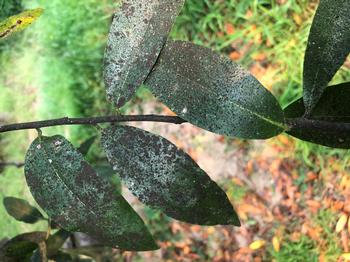The sticky problem of honeydew and how to tackle it
-
Martha Proctor
-
Honeydew is the name which describes the sweet, sticky fluid that plant-sucking insects excrete via their anus onto leaves. These sucking pests are in the order Hemiptera and include adult and lymph stages of insects such as aphids, soft scales, whiteflies, leafhoppers, mealybugs, and psyllids. All of these insects feed through a hollow, needle-shaped mouth that they insert into plants’ phloem tissues in leaves or beneath bark. Phloem tissues conduct sugars and other metabolites from leaves to the rest of the plant. Any excess sugar-water is excreted as tiny droplets that speckle leaves, cars, and patios. While moderate amounts of honeydew are not damaging to plants and can act as food and location cues for natural enemies, heavy concentrations of honeydew can interfere with those beneficials’ effectiveness by trapping them.
Sooty mold, in turn, is the common name applied to the dark, nonpathogenic fungi that grow superficially on leaves and other surfaces fouled with insect honeydew. Sooty mold fungi are decomposers that break down honeydew as their source of nutrition. They do not directly draw any sustenance from the host plant on which they reside and are generally harmless to plants. Sooty mold can be ignored except when leaves are so heavily coated that sunlight cannot penetrate and photosynthesis is reduced. This can result in stressed plants and stunted growth which can, in turn, lead to premature leaf drop. Sooty mold on bay leaves fouled by insect honeydew. Photo credit: Martha Proctor
Sooty mold on bay leaves fouled by insect honeydew. Photo credit: Martha ProctorMinor infestations can be dealt with by judicious pruning or by simply wiping blackened leaves with a soft cloth to reveal healthy plant tissue. In cases where access isn’t so easy, it can be completely washed off with a forceful steam of water. This will control most exposed sap-sucking insects while also helping to wash away honeydew and sooty mold.
For chronic infestations, longer-term control involves managing the insects who create honeydew. Cutting back on cultural practices that stimulate growth, such as heavy nitrogen fertilization and pruning, assists in discouraging honeydew producers. Natural enemies normally take care of minor infestations before long, so chronic infestations are usually a sign that something else is hampering natural control: ants. Ants behave something akin to ranchers tending dairy cattle. They defend honeydew-producing insects from predators and parasites while harvesting honeydew as a prized food source.
The first step is to deny ants access to their food. Apply a sticky material like Tanglefoot to the trunks of trees and trim branches to eliminate potential bridges to structures or other plants. Battling larger ant colonies can be challenging. If the above approaches aren’t enough, a slow-acting insecticide bait such as Abamectin or borate mixed with an attractant has been shown to be effective, as it allows the toxicant to be spread to other ants in the nest. However, this approach won’t work well unless access to honeydew has been prevented. There’s just nothing quite as attractive to ants as honeydew, so if it’s around, the ants won’t go for bait.
To protect plants from overwintering aphid eggs and scales, apply horticultural oils in spring prior to bud break. An insecticidal soap or pyrethroid can be used to combat nymphs, crawlers and adults when present.
To protect plants from overwintering scales and/or aphid eggs, apply horticultural oils in spring prior to bud break. An insecticidal soap or pyrethroid can be used to combat nymphs, crawlers and adults when present.
To ensure that you are encouraging a healthy environment for your garden plants, select healthy plants that thrive in your garden’s microclimate, nourish the soil, and water the plants according to their needs. Monitor them frequently for signs of pest damage so you can institute control measures before problems become harder to address.

